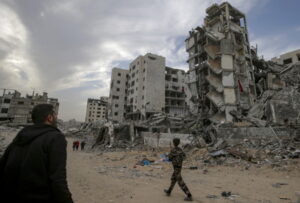It seems that the dream for thousands of young Greeks of finally putting “a roof over their heads” is vanishing. The state’s good intentions don’t seem to be enough, as the provision of the”My House II” programme for properties with planning permission until 2005 has pushed prices (further) upwards for property more than half a century old. Compounding this are the tight time limits from the issuance of the certificate of inclusion to the completion of the process.
Which explains the rather lukewarm public response to the program, which the banks are calling for to be extended in time beyond 2026, and the “alarm” that most of the 2 billion euros that the program is going to make available will be lost, as prospective buyers either don’t find a house that meets the criteria, or the one they do find is so old and expensive that the benefits of the program evaporate…
No advantage
In practice, with the prices of properties built in the 1970s on fire, in some cases exceeding even 200,000 euros (!), program participants realize that they will have to take up a hefty mortgage for their first home, to find more money immediately for the required renovation work. Added to this are the concerns of civil engineers about the potential fatigue of materials in very old structures, which add to the reluctance, if not reluctance, of potential buyers to proceed with acquiring old properties through the program.
There are many participants in the My House II program, but the problem is what the market imagined. Especially in the capital region, where there is the greatest demand, the eligible properties with a price of up to 250,000 euros are very few, and those that exist are particularly old. Moreover, due to the renovation required to make them habitable and the high purchase price, they are considered overpriced, to the extent that the beneficiaries of the program are being put off by the low cost of borrowing offered by the program.
Bureaucracy
As if that weren’t enough, as the beneficiaries of “My House II” struggle with bureaucracy to get into the program, they run into the often unreasonable demands of sellers, who ask for massive down payments before the loan is even approved and a legal and technical check is done by the bank, while some adjust the price upwards – up to 10%!
This is the second wave of revaluations in the year, which in some areas, such as Pagrati, are as high as 20%-30% by early 2025, as many property owners have been waiting for the release of the scheme’s criteria to raise their sale prices!
The absurdly high sales prices for properties that are rather disappointing and the “forced” age of the homes on offer are already acting as a disincentive to a large proportion of scheme participants. Particularly if we take into account that the beneficiaries of “My House II” are mainly young people with low incomes and coming from the middle class, as the average annual income of the first approved borrowers did not exceed €21,300.
And that’s not all. Based on available data from the program, only one in ten beneficiaries of the program who applied to a bank have found a home. What’s more, of the more than 100,000 who have applied across the country, only to have about 20,000 approved, two and a half months after the program’s launch,h only 1,700 have seen their applications approved and the associated funds committed, compared to 20,000 who have been approved.
Homes (not) available
Anyway, the homes that do exist for program beneficiaries are neither more nor… very new, particularly in Athens and Thessaloniki. As predicted by the real estate market analysis website Spitogatos’ analysis of price trends as well as the supply of residential properties for sale that meet the housing program’s criteria, eligible homes in the southern suburbs, specifically in Glyfada, were built around 1970, have an average square footage of 65 square meters and are available for 200,000 euros on average.
In the center of Athens, in Pagrati, the houses that meet the criteria for the program were also built in 1970, with an average area of 60 sq m., and the price ranging around 160,000 euros. In Piraeus, in the center of the country’s largest port, the average construction date of eligible properties that meet the criteria rises slightly, to 1974, with the average area reaching 66 sq m and the average asking price at 185,000 euros.
A recent survey (data up to March 18) by Resolute Cepal, Greece’s property management and servicer ReDatase, shows that there are relatively few properties eligible for the scheme that have been built relatively recently. Most of the properties eligible for “My House II” in the Municipality of Athens were built in the 1970s, with an average area of 70-75 sqm and a price of around 150,000 euros. The cheapest houses are located in the area of Viktoria Square with an average price of 1,580 euros per square meter, in Patisia with 1,620 euros per square meter, and in Sepolia with 1,780 euros per square meter.
Golden… ruins
Things are better (?) in the western suburbs of Athens, such as Peristeri, Kamatero, and Ilion, where beneficiaries of the program can find prices around 150,000 euros for houses of 85-90 sq.m built in the 1980s. For newer eligible homes, built in the 1990s, one should look in eastern Attica, such as in Koropi and Pallini, but also pay close to 200,000 euros for 85-90 sq.m. Prices range from 1,750 to 2,460 euros per sq.m for homes with an average surface area of 68 to 81 sq.m in Galati, where the average years of construction are between 1977 and 1981.
In Piraeus, for an average surface area of 77 to 85 sq m., one will have to pay between 1,580 and 2,030 euros to buy a house with an average year of construction between 1982 and 1987, with the most recent properties recorded in Perama. Most eligible properties in the Municipality of Thessaloniki are built in the 70s, with a surface area of 59-76 sq.m and prices ranging from 1,900 euros per sq.m. in Harilaou to 2,580 euros per sq.m. in the historic centre.
However, those who manage to buy a house through the government’s housing program seem to be on a one-way street for choosing a property from the 1970s. Moreover, according to a market analysis by Spitogatos on the majority of available homes that meet the criteria of the “My House II” program, more than 55% of Attica’s housing supply is concentrated in two areas: the center of Athens and the southern suburbs, followed by the western suburbs and the areas of Piraeus, which account for just over 8% of the supply of homes compatible with the program. In the Prefecture of Thessaloniki, more than 50% of the available homes for sale are located within the Municipality of Thessaloniki.
More than 50% of the total number of Thessaloniki apartments is located in the Thessaloniki region.
The only areas in which the average construction date of the properties is the 1980s and which meet the criteria of the programme are located in the rest of the Prefecture of Thessaloniki (1982, with an average area of 90 m2 and an average sales price of 80,000 euro or 940 euro per m2), the suburbs of Thessaloniki (1985, with an average area of 85 m2 and an average price of 940 euro per m2), the suburbs of Thessaloniki (1985, with an average area of 85 m2 and an average price of 940 euro per m2), the suburbs of the city of Thessaloniki and the suburbs of the city of Thessaloniki.m and an average selling price of 119,000 euros or 1,400 euros per square metre), the east of Athens (1985, with an average area of 88 square metres and an average price of 180,000 euros or 2,000 euros per square metre) and the rest of Attica (with an average construction date of 1985, an average area of 85 square metres and an average selling price of 150,000 euros or 1,667 euros per square metre).
Requirements
“It’s a free market, we’ll do what we want”, or “whoever doesn’t like it, doesn’t buy it”. These are the arguments -mainly- used by property owners who are trying to make excessive profit by taking advantage of the circumstances (low housing stock, opportunity offered by the favorable “My House II” home acquisition program), throwing the promising opportunity for tens of thousands of citizens to deal with the housing crisis on the rocks.
The government’s housing program, which offers favorable financial terms for young people and couples aged 25-50 to buy their first home, with subsidized loans with income criteria tailored to each family situation, stipulates that eligible properties under the program must have building permits as of 2005 and a year of completion by 2007, not exceeding 150 square meters in area. and not exceed a contract value of EUR 250,000. The houses that can be included are more than 20 years old, while the previous “My House I” included houses that were 15 years old.
In addition, many prospective buyers are wondering why homes that are presumed to have been built under the new seismic regulations are excluded. As those of the beneficiaries of the programme who can reach the amount of 250,000 euros are few, the additional costs, such as the equity of more than 60,000 euros, together with the costs of transfer and registration in the Land Registry, the costs of issuing an electronic building identity card and the money required for renovation (heating, windows, doors, etc.), also act as disincentives.
Government sources tell”THEMA” that they are aware of the problem with the distortion caused by the very high prices of eligible properties and the restrictions imposed by the program. Other sources point out that one solution could be to modify the terms of the program by relaxing the age of eligible properties (allowing even newly built properties or even building on land), and also if the government does not accept the banks’ request for a time extension of the “My House II” program.
The risks
Added to these are the doubts about the vulnerability of such old buildings built to the older building and seismic regulations (before the big 1981 and 1999 earthquakes), possibly with fewer materials (e.g. iron) and other types of concrete.
Besides, in the most earthquake-prone country in Europe (yes, Greece for those who don’t know), property owners are not required to do regular structural stability checks (e.g., oxidation of reinforcement and carbonation of concrete, resulting from prolonged moisture and exposure to water), nor in structural reinforcements to bring old buildings closer to the requirements of the newer structural, seismic codes. So -and- a big question arises about the safety of above-ground buildings whose purchase is subsidized.
Ask me anything
Explore related questions





